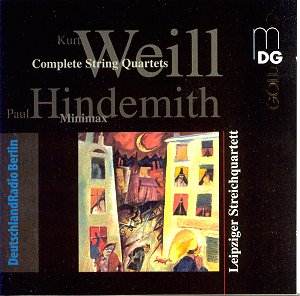 Composer: Paul Hindemith
Composer: Paul Hindemith
Works: Minimax – Repertorium für Militärmusik (1923); Kurt Weill: String Quartet No. 1 (1919), String Quartet No. 2 Op. 8 (1922-23)
Performers: Leipziger Streichquartett
Recording: Recorded 28-30 Mar 2001 at Markkleeburg (Weill), Fürstliche Reitbahn Bad Arolsen
Label: MDG GOLD 307 1071-2
The collaboration between Paul Hindemith and Kurt Weill offers a fascinating glimpse into the evolution of early 20th-century music, highlighting their distinct compositional voices while revealing their shared heritage within the Germanic tradition. Hindemith, a composer known for his harmonic innovation and complex counterpoint, and Weill, who would later embrace the theatricality and social engagement of musical theatre, each contribute to a recording that juxtaposes their early chamber works. This release not only showcases their contrasting styles but also places them within the broader cultural and historical narrative of post-World War I Germany.
Weill’s String Quartet No. 1, composed in 1919, exudes an elegance that belies its historical context. The work is imbued with a Schubertian lyricism that captures the nuanced emotions of a composer on the brink of his stylistic transformation. The Leipziger Streichquartett navigates the lyrical lines with a refined touch, revealing the quartet’s inherent beauty while allowing the subtler harmonies to resonate. The Langsam movement, in particular, stands out with its lush textures reminiscent of Reger’s andantes, demonstrating Weill’s burgeoning melodic gift. However, the final movement’s adherence to conventional structures can feel slightly fatigued, as its thematic development does not fully engage the listener’s attention, a minor flaw in an otherwise engaging work.
Contrasting sharply with Weill’s early romanticism, his String Quartet No. 2, Op. 8, composed under Busoni’s influence in the early 1920s, embraces a more objective, emotionally restrained style. The performance here is marked by its clarity and precision, capturing the essence of the “Junge Klassizität” movement that Weill was engaging with at the time. The lively interplay in the outer movements is executed with a delightful buoyancy, while the Choralphantasie finale offers a moment of gravitas, drawing on Bach’s influence. While the second movement’s playful motifs align with the lightness of the preceding movements, the return to complexity in the finale lacks the compelling airiness that characterized the earlier sections, revealing a tension between simplicity and intellectual rigor that Weill navigated with varying success.
Hindemith’s Minimax stands as a humorous suite that effectively parodies the martial music of his time, presenting a lighter facet of his compositional style. The Leipziger Streichquartett brings an invigorating vitality to the work, executing the absurdities of military pride with deftness and charm. The humorous elements, including sliding wrong notes and a playful take on well-known themes, showcase Hindemith’s wit and inventive spirit. Here, the ensemble’s technical prowess shines through, particularly in the intermezzo, where the two violins emulate distant trumpets with striking clarity. This playful approach contrasts with the more serious undertones of Weill’s quartets, yet both composers share an underlying critique of societal norms through their music.
The recording quality enhances the listening experience, with crisp articulation and a balanced soundstage that allows for the intricate counterpoint and harmonic richness to emerge distinctly. The engineering captures the nuances of the ensemble’s dynamics, enabling the listener to appreciate both the subtleties and the exuberances of the performances. The attention to detail in the recording complements the lively interpretations, making it an engaging experience for both seasoned listeners and newcomers alike.
This recording serves as a compelling exploration of two pivotal figures in 20th-century music, each navigating their unique paths while reflecting the cultural complexities of their time. The Leipziger Streichquartett’s interpretations breathe new life into these works, balancing precision with emotional depth. The juxtaposition of Weill’s early lyricism alongside Hindemith’s playful satire creates a rich tapestry of sound and thought that resonates beyond its historical context, offering insights into the artistic responses to a fractured world.



